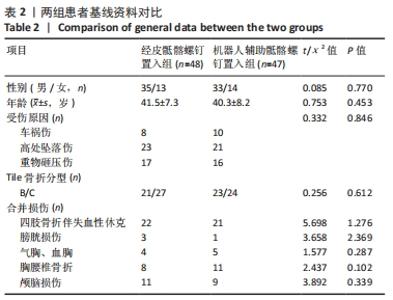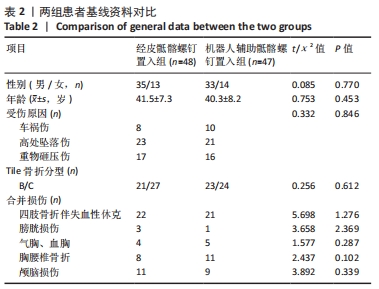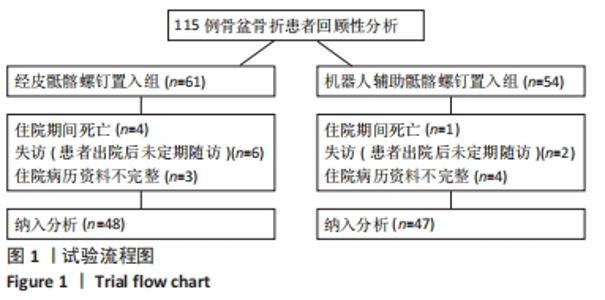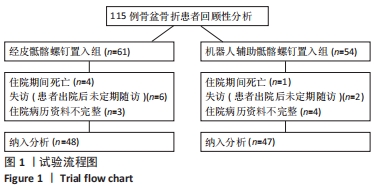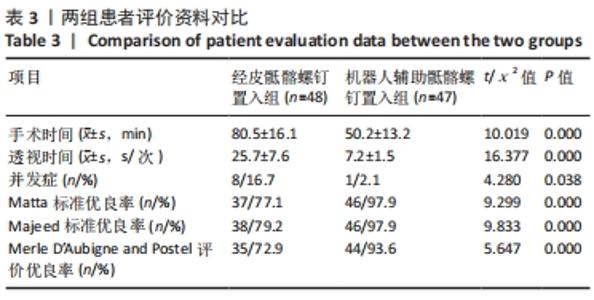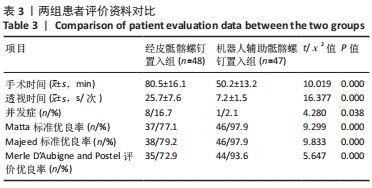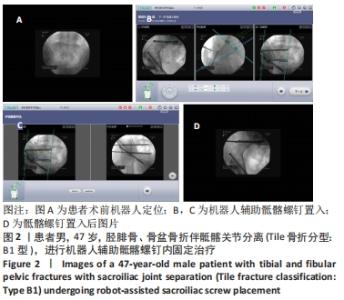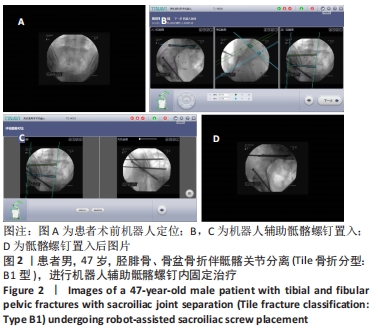[1] HAUSCHILD O, STROHM PC, CULEMANN U, et al. Mortality in patients with pelvic fractures: results from the German pelvic injury register.J Trauma. 2008;64(2):449-455.
[2] LIUZZA F, SILLUZIO N, FLORIO M, et al. Comparison between posterior sacral plate stabilization versus minimally invasive transiliac-transsacral lag-screw fixation in fractures of sacrum: a single-centre experience. Int Orthop. 2019;43(1):177-185.
[3] COLLINGE C, COONS D, TORNETTA P, et al. Standard multiplanar fluoroscopy versus a fluoroscopically based navigation system for the percutaneous insertion of iliosacral screws: a cadaver model. J Orthop Trauma. 2005;19(4):254-258.
[4] MAJEED SA. Grading the outcome of pelvic fractures. J Bone Joint Surg Br. 1989;71(2):304-306.
[5] DUDDA M, HOFFMANN M, SCHILDHAUER TA. Sacrum fractures and lumbopelvic instabilities in pelvic ring injuries: classification and biomechanical aspects. Unfallchirurg. 2013;116(11):972-978.
[6] LINDSAY A, TORNETTA P 3RD, DIWAN A, et al. Is Closed Reduction and Percutaneous Fixation of Unstable Posterior Ring Injuries as Accurate as Open Reduction and Internal Fixation? J Orthop Trauma. 2016;30(1):29-33.
[7] SUERO EM, GREINER A, BECKER CA, et al. Biomechanical stability of sacroiliac screw osteosynthesis with and without cement augmentation. Injury. 2020 Jan 30.doi: 10.1016/j.injury.2020.01.043.
[8] 刘钢,杨强,郝永宏,等.第2骶椎骶髂螺钉固定骶骨骨盆的优势及意义[J].中国组织工程研究,2021,25(21):3395-3400.
[9] 孟士超,吴斗,赵恩哲,等.骶髂螺钉治疗骨盆后环骨折及辅助置钉技术的研究进展[J].中华老年骨科与康复电子杂志,2021,7(3):187-192.
[10] 张玉坤,李磊,任军.骶髂关节不同固定方式对骶部影响的生物力学研究[J].中华骨与关节外科杂志,2021,14(2):92-96.
[11] HINSCHE AF, GIANNOUDIS PV, SMITH RM. Fluoroscopy-based multiplanar image guidance for insertion of sacroiliac screws. Clin Orthop Relat Res. 2002;(395):135-144.
[12] 邓宁,吴伟坚,梁国穗,等.机器人和计算机辅助骨科手术[J].中华创伤骨科杂志,2005,7(7):620-624.
[13] LEAL GHEZZI T, CAMPOS CORLETA O. 30 Years of Robotic Surgery. World J Surg. 2016;40(10):2550-2557.
[14] PAUL HA, BARGAR WL, MITTLESTADT B, et al. Development of a surgical robot for cementless total hip arthroplasty. Clin Orthop Relat Res. 1992; (285):57-66.
[15] SAUTOT P,CINQUIN P, LAVALLÉE S,et al.Computer assisted spine surgery: A first step toward clinical, application in orthopaedics//1992 14th Annual International Conference of the IEEE Engineering in Medicine and Biology Society. IEEE, 1992.
[16] MOLLIQAJ G, SCHATLO B, ALAID A, et al. Accuracy of robot-guided versus freehand fluoroscopy-assisted pedicle screw insertion in thoracolumbar spinal surgery. Neurosurg Focus. 2017;42(5):E14.
[17] 王成勇,谢国能,赵丹娜,等.医疗手术机器人发展概况[J].工具技术,2016,50(7):3-12.
[18] 张鹤,韩建达,周跃.脊柱微创手术机器人系统辅助打孔的实验研究[J].中华创伤骨科杂志,2011,13(12):1166-1169.
[19] TIAN W, HAN X, LIU B, et al. A robot-assisted surgical system using a force-image control method for pedicle screw insertion. PLoS One. 2014;9(1):e86346.
[20] 蒋侃凌,田维,贾健,等. TiRobot手术机器人辅助经皮骶髂螺钉固定治疗骨盆后环不稳定损伤[J].天津医科大学学报,2017,23(3): 247-251.
[21] 赵春鹏,王军强,苏永刚,等.机器人辅助经皮螺钉内固定治疗骨盆和髋臼骨折[J].北京大学学报(医学版),2017,49(2):274-280.
[22] ZWINGMANN J, KONRAD G, MEHLHORN AT, et al. Percutaneous iliosacral screw insertion: malpositioning and revision rate of screws with regards to application technique (navigated vs. Conventional). J Trauma. 2010;69(6):1501-1506.
[23] ZWINGMANN J, HAUSCHILD O, BODE G, et al. Malposition and revision rates of different imaging modalities for percutaneous iliosacral screw fixation following pelvic fractures: a systematic review and meta-analysis. Arch Orthop Trauma Surg. 2013;133(9):1257-1265.
[24] ZWINGMANN J, KONRAD G, KOTTER E, et al. Computer-navigated iliosacral screw insertion reduces malposition rate and radiation exposure. Clin Orthop Relat Res. 2009;467(7):1833-1838.
[25] WEBB JE, REGEV GJ, GARFIN SR, et al. Navigation-assisted fluoroscopy in minimally invasive direct lateral interbody fusion: a cadaveric study. SAS J. 2010;4(4):115-121.
[26] KIM JW, OH CW, OH JK, et al. Percutaneous iliosacral screwing in pelvic ring injury using three-dimensional fluoroscopy. J Orthop Sci. 2013; 18(1):87-92.
[27] HE M, HAN W, ZHAO CP, et al. Evaluation of a Bi-Planar Robot Navigation System for Insertion of Cannulated Screws in Femoral Neck Fractures. Orthop Surg. 2019;11(3):373-379.
[28] ECKER TM, JOST J, CULLMANN JL, et al. Percutaneous screw fixation of the iliosacral joint: A case-based preoperative planning approach reduces operating time and radiation exposure. Injury. 2017;48(8): 1825-1830.
[29] 贾帅军,吕尚军,贺利军,等.三维导航技术辅助经皮骶髂螺钉治疗骨盆后环骨折[J].创伤外科杂志,2014,16(6):506-510.
[30] STÖCKLE U, SCHASER K, KÖNIG B. Image guidance in pelvic and acetabular surgery--expectations, success and limitations. Injury. 2007; 38(4):450-462.
|
